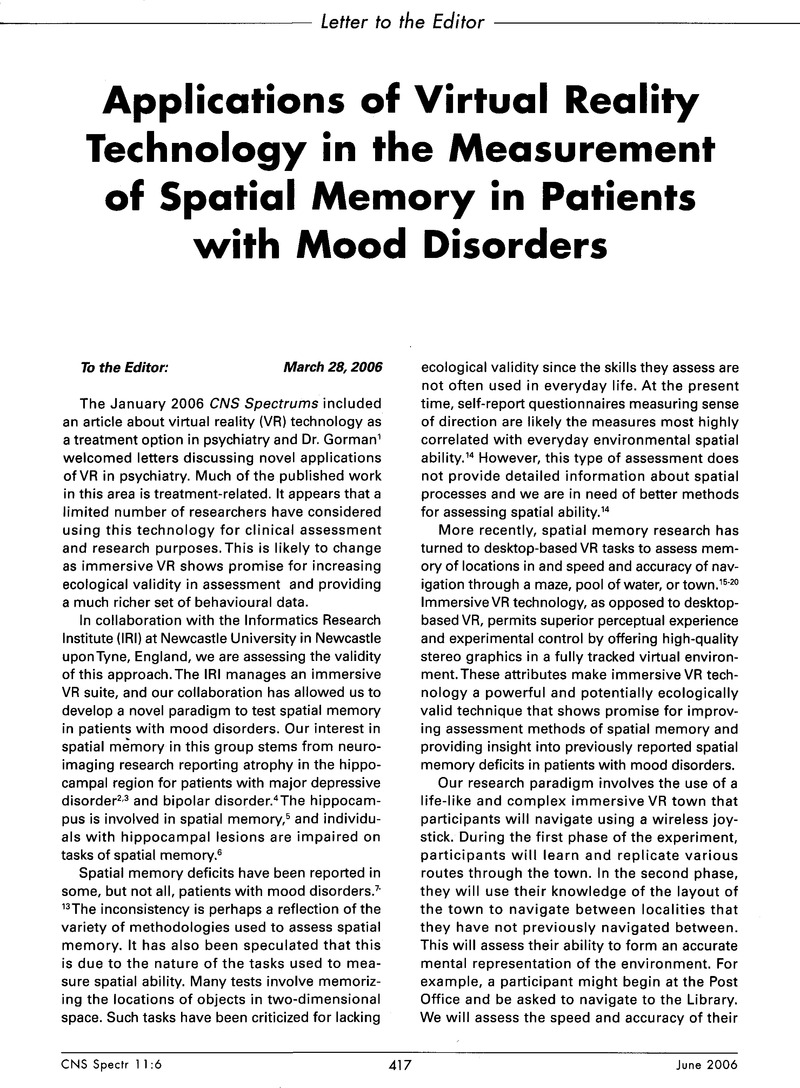No CrossRef data available.
Article contents
Applications of Virtual Reality Technology in the Measurement of Spatial Memory in Patients with Mood Disorders
Published online by Cambridge University Press: 07 November 2014
Abstract
An abstract is not available for this content so a preview has been provided. As you have access to this content, a full PDF is available via the ‘Save PDF’ action button.

- Type
- Letter to the Editor
- Information
- Copyright
- Copyright © Cambridge University Press 2006
References
REFERENCES
2.Sheline, YI, Wang, PW, Gado, MH, Csernansky, JG, Vannier, MW. Hippocampal atrophy in recurrent major depression. Proc Natl Acad Sci U S A. 1996;93:3908–3913.CrossRefGoogle ScholarPubMed
3.Hickie, I, Naismith, S, Ward, PB, et al.Reduced hippocampal volumes and memory loss in patients with early- and late-onset depression. Br J Psychiatry. 2005;186:197–202.Google Scholar
4.Blumberg, HP, Kaufman, J, Martin, A, et al.Amygdala and hippocampal volumes in adolescents and adults with bipolar disorder. Arch Gen Psychiatry. 2003;60:1201–1208.Google Scholar
5.Zola, SM, Squire, LR. The medial temporal lobe and the hippocampus. In: Tulving, E, Craik, FIM, eds. The Oxford Handbook of Memory. New York, NY: Oxford University Press: 2000:485–500.CrossRefGoogle Scholar
6.Kessels, RP, de Haan, EH, Kappelle, LJ, Postma, A. Varieties of human spatial memory: a meta-analysis on the effects of hippocampal lesions. Brain Res Brain Res Rev. 2001;35:295–303.CrossRefGoogle ScholarPubMed
7.Sweeney, JA, Kmiec, JA, Kupfer, DJ. Neuropsychologic impairments in bipolar and unipolar mood disorders on the CANTAB neurocognitive battery. Biol Psychiatry. 2000;48:674–684.Google Scholar
8.Weiland-Fiedler, P, Erickson, K, Waldeck, T, et al.Evidence for continuing neuropsychological impairments in depression. J Affect Disord. 2004;82:253–258.Google Scholar
9.Rubinsztein, JS, Michael, A, Paykel, ES, Sahakian, BJ. Cognitive impairment in remission in bipolar affective disorder. Psychol Med. 2000;30:1025–1036.CrossRefGoogle ScholarPubMed
10.Porter, RJ, Gallagher, P, Thompson, JM, Young, AH. Neurocognitive impairment in drugfree patients with major depressive disorder. Br J Psychiatry. 2003;182:214–220.Google Scholar
11.Murphy, FC, Sahakian, BJ, Rubinsztein, JS, et al.Emotional bias and inhibitory control processes in mania and depression. Psychol Med. 1999;29:1307–1321.Google Scholar
12.Hill, SK, Keshavan, MS, Thase, ME, Sweeney, JA. Neuropsychological dysfunction in antipsychotic-naive first-episode unipolar psychotic depression. Am J Psychiatry. 2004;161:996–1003.CrossRefGoogle ScholarPubMed
13.Larson, ER, Shear, PK, Krikorian, R, Welge, J, Strakowski, SM. Working memory and inhibitory control among manic and euthymic patients with bipolar disorder. J Int Neuropsychol Soc. 2005;11:163–172.CrossRefGoogle ScholarPubMed
14.Waller, D. The WALKABOUT: Using virtual environments to assess large-scale spatial abilities. Comput Human Behav. 2005;21:243–253.Google Scholar
15.Astur, RS, Taylor, LB, Mamelak, AN, Philpott, L, Sutherland, RJ. Humans with hippocampus damage display severe spatial memory impairments in a virtual Morris water task. Behav Brain Res. 2002;132:77–84.Google Scholar
16.Driscoll, I, Hamilton, DA, Yeo, RA, Brooks, WM, Sutherland, RJ. Virtual navigation in humans: the impact of age, sex, and hormones on place learning. Horm Behav. 2005;47:326–335.Google Scholar
17.Hartley, T, Maguire, EA, Spiers, HJ, Burgess, N. The well-worn route and the path less traveled: distinct neural bases of route following and wayfinding in humans. Neuron. 2003;37:877–888.Google Scholar
18.Maguire, EA, Burgess, N, Donnett, JG, et al.Knowing where and getting there: a human navigation network. Science. 1998;280:921–924.Google Scholar
19.Pine, DS, Grun, J, Maguire, EA, et al.Neurodevelopmental aspects of spatial navigation: a virtual reality fMRI study. Neuroimage. 2002;15:396–406.Google Scholar
20.Shore, DI, Stanford, L, MacInnes, WJ, Klein, RM, Brown, RE. Of mice and men: virtual Hebb-Williams mazes permit comparison of spatial learning across species. Cogn Affect Behav Neurosci. 2001;1:83–89.Google Scholar


